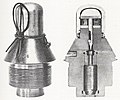Plik:No106FuzeSectionPhoto.jpg

Rozmiar podglądu – 712 × 600 pikseli. Inne rozdzielczości: 285 × 240 pikseli | 570 × 480 pikseli.
Rozmiar pierwotny (800 × 674 pikseli, rozmiar pliku: 109 KB, typ MIME: image/jpeg)
Historia pliku
Kliknij na datę/czas, aby zobaczyć, jak plik wyglądał w tym czasie.
| Data i czas | Miniatura | Wymiary | Użytkownik | Opis | |
|---|---|---|---|---|---|
| aktualny | 08:12, 5 lip 2008 |  | 800 × 674 (109 KB) | Rcbutcher | {{Information |Description= |Source= |Date= |Author= |Permission= |other_versions= }} |
| 12:48, 29 cze 2008 |  | 640 × 534 (200 KB) | Rcbutcher | {{Information |Description=Photograph showing sectioned British No. 106 direct-action percussion fuze, World War I vintage. |Source=British ordnance manual circa. 1916-1918 |Date=circa. 1916-1918 |Author=War Office, UK |Permission=Crown copyright expired |
Lokalne wykorzystanie pliku
Poniższa strona korzysta z tego pliku:
Globalne wykorzystanie pliku
Ten plik jest wykorzystywany także w innych projektach wiki:
- Wykorzystanie na da.wikipedia.org
- Wykorzystanie na de.wikipedia.org
- Wykorzystanie na en.wikipedia.org
- Wykorzystanie na lt.wikipedia.org
- Wykorzystanie na pt.wikipedia.org
- Wykorzystanie na ru.wiktionary.org
- Wykorzystanie na uk.wikipedia.org
- Wykorzystanie na www.wikidata.org
